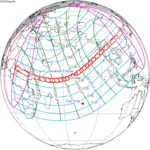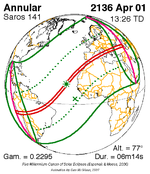Solar eclipse of November 11, 1901
20th-century annular solar eclipse From Wikipedia, the free encyclopedia
An annular solar eclipse occurred at the Moon's ascending node of orbit on Monday, November 11, 1901,[1][2][3] with a magnitude of 0.9216. A solar eclipse occurs when the Moon passes between Earth and the Sun, thereby totally or partly obscuring the image of the Sun for a viewer on Earth. An annular solar eclipse occurs when the Moon's apparent diameter is smaller than the Sun's, blocking most of the Sun's light and causing the Sun to look like an annulus (ring). An annular eclipse appears as a partial eclipse over a region of the Earth thousands of kilometres wide. Occurring about 4.5 hours before apogee (on November 11, 1901, at 12:00 UTC), the Moon's apparent diameter was smaller.[4]
Annularity was visible from the Italian island Sicily, the whole British Malta (now Malta), Ottoman Tripolitania (now Libya), Egypt, Ottoman Empire (parts now belonging to Cretan State in Greece, Israel, Jordan and Saudi Arabia), Emirate of Jabal Shammar (now belonging to Saudi Arabia), Aden Protectorate (now belonging to Yemen), Muscat and Oman (now Oman), British Raj (the parts now belonging to India, Andaman and Nicobar Islands and Myanmar), British Ceylon (now Sri Lanka), Siam (name changed to Thailand later), French Indochina (the parts now belonging to Cambodia, southern tip of Laos and southern Vietnam, including Phnom Penh), Bombay Reef in the Paracel Islands, and Philippines. A partial eclipse was visible for parts of North Africa, East Africa, most of Asia, and Northern Australia.
Eclipse details
Summarize
Perspective
Shown below are two tables displaying details about this particular solar eclipse. The first table outlines times at which the moon's penumbra or umbra attains the specific parameter, and the second table describes various other parameters pertaining to this eclipse.[5]

| Event | Time (UTC) |
|---|---|
| First Penumbral External Contact | 1901 November 11 at 04:29:38.4 UTC |
| First Umbral External Contact | 1901 November 11 at 05:39:58.5 UTC |
| First Central Line | 1901 November 11 at 05:43:40.3 UTC |
| First Umbral Internal Contact | 1901 November 11 at 05:47:24.1 UTC |
| Equatorial Conjunction | 1901 November 11 at 07:17:59.6 UTC |
| Greatest Eclipse | 1901 November 11 at 07:28:20.9 UTC |
| Ecliptic Conjunction | 1901 November 11 at 07:34:04.9 UTC |
| Greatest Duration | 1901 November 11 at 07:34:34.5 UTC |
| Last Umbral Internal Contact | 1901 November 11 at 09:09:25.3 UTC |
| Last Central Line | 1901 November 11 at 09:13:09.0 UTC |
| Last Umbral External Contact | 1901 November 11 at 09:16:50.9 UTC |
| Last Penumbral External Contact | 1901 November 11 at 10:27:08.6 UTC |
| Parameter | Value |
|---|---|
| Eclipse Magnitude | 0.92156 |
| Eclipse Obscuration | 0.84926 |
| Gamma | 0.47576 |
| Sun Right Ascension | 15h03m02.2s |
| Sun Declination | -17°15'48.8" |
| Sun Semi-Diameter | 16'09.6" |
| Sun Equatorial Horizontal Parallax | 08.9" |
| Moon Right Ascension | 15h03m21.4s |
| Moon Declination | -16°50'38.2" |
| Moon Semi-Diameter | 14'41.8" |
| Moon Equatorial Horizontal Parallax | 0°53'56.3" |
| ΔT | -0.3 s |
Eclipse season
This eclipse is part of an eclipse season, a period, roughly every six months, when eclipses occur. Only two (or occasionally three) eclipse seasons occur each year, and each season lasts about 35 days and repeats just short of six months (173 days) later; thus two full eclipse seasons always occur each year. Either two or three eclipses happen each eclipse season. In the sequence below, each eclipse is separated by a fortnight.
| October 27 Descending node (full moon) | November 11 Ascending node (new moon) |
|---|---|
 |  |
| Partial lunar eclipse Lunar Saros 115 |
Annular solar eclipse Solar Saros 141 |
Related eclipses
Eclipses in 1901
- A penumbral lunar eclipse on May 3.
- A total solar eclipse on May 18.
- A partial lunar eclipse on October 27.
- An annular solar eclipse on November 11.
Metonic
- Preceded by: Solar eclipse of January 22, 1898
- Followed by: Solar eclipse of August 30, 1905
Tzolkinex
- Preceded by: Solar eclipse of September 29, 1894
- Followed by: Solar eclipse of December 23, 1908
Half-Saros
- Preceded by: Lunar eclipse of November 4, 1892
- Followed by: Lunar eclipse of November 17, 1910
Tritos
- Preceded by: Solar eclipse of December 12, 1890
- Followed by: Solar eclipse of October 10, 1912
Solar Saros 141
- Preceded by: Solar eclipse of October 30, 1883
- Followed by: Solar eclipse of November 22, 1919
Inex
- Preceded by: Solar eclipse of November 30, 1872
- Followed by: Solar eclipse of October 21, 1930
Triad
- Preceded by: Solar eclipse of January 10, 1815
- Followed by: Solar eclipse of September 11, 1988
Solar eclipses of 1898–1902
This eclipse is a member of a semester series. An eclipse in a semester series of solar eclipses repeats approximately every 177 days and 4 hours (a semester) at alternating nodes of the Moon's orbit.[6]
The solar eclipses on January 22, 1898 (total) and July 18, 1898 (annular) occur in the previous lunar year eclipse set, and the partial solar eclipse on April 8, 1902 occurs in the next lunar year eclipse set.
| Solar eclipse series sets from 1898 to 1902 | ||||||
|---|---|---|---|---|---|---|
| Ascending node | Descending node | |||||
| Saros | Map | Gamma | Saros | Map | Gamma | |
| 111 | December 13, 1898 Partial |
−1.5252 | 116 | June 8, 1899 Partial |
1.2089 | |
| 121 | December 3, 1899 Annular |
−0.9061 | 126 Totality in Wadesboro, North Carolina |
May 28, 1900 Total |
0.3943 | |
| 131 | November 22, 1900 Annular |
−0.2245 | 136 | May 18, 1901 Total |
−0.3626 | |
| 141 | November 11, 1901 Annular |
0.4758 | 146 | May 7, 1902 Partial |
−1.0831 | |
| 151 | October 31, 1902 Partial |
1.1556 | ||||
Saros 141
This eclipse is a part of Saros series 141, repeating every 18 years, 11 days, and containing 70 events. The series started with a partial solar eclipse on May 19, 1613. It contains annular eclipses from August 4, 1739 through October 14, 2640. There are no hybrid or total eclipses in this set. The series ends at member 70 as a partial eclipse on June 13, 2857. Its eclipses are tabulated in three columns; every third eclipse in the same column is one exeligmos apart, so they all cast shadows over approximately the same parts of the Earth.
The longest duration of annularity was produced by member 20 at 12 minutes, 9 seconds on December 14, 1955. All eclipses in this series occur at the Moon’s ascending node of orbit.[7]
| Series members 12–33 occur between 1801 and 2200: | ||
|---|---|---|
| 12 | 13 | 14 |
 September 17, 1811 |
 September 28, 1829 |
 October 9, 1847 |
| 15 | 16 | 17 |
 October 19, 1865 |
 October 30, 1883 |
 November 11, 1901 |
| 18 | 19 | 20 |
 November 22, 1919 |
 December 2, 1937 |
 December 14, 1955 |
| 21 | 22 | 23 |
 December 24, 1973 |
 January 4, 1992 |
 January 15, 2010 |
| 24 | 25 | 26 |
 January 26, 2028 |
 February 5, 2046 |
 February 17, 2064 |
| 27 | 28 | 29 |
 February 27, 2082 |
 March 10, 2100 |
 March 22, 2118 |
| 30 | 31 | 32 |
 April 1, 2136 |
 April 12, 2154 |
 April 23, 2172 |
| 33 | ||
 May 4, 2190 | ||
Metonic series
The metonic series repeats eclipses every 19 years (6939.69 days), lasting about 5 cycles. Eclipses occur in nearly the same calendar date. In addition, the octon subseries repeats 1/5 of that or every 3.8 years (1387.94 days). All eclipses in this table occur at the Moon's ascending node.
| 25 eclipse events between April 5, 1837 and June 17, 1928 | ||||
|---|---|---|---|---|
| April 5–6 | January 22–23 | November 10–11 | August 28–30 | June 17–18 |
| 107 | 109 | 111 | 113 | 115 |
 April 5, 1837 |
 January 22, 1841 |
 November 10, 1844 |
 August 28, 1848 |
 June 17, 1852 |
| 117 | 119 | 121 | 123 | 125 |
 April 5, 1856 |
 January 23, 1860 |
 November 11, 1863 |
 August 29, 1867 |
 June 18, 1871 |
| 127 | 129 | 131 | 133 | 135 |
 April 6, 1875 |
 January 22, 1879 |
 November 10, 1882 |
 August 29, 1886 |
 June 17, 1890 |
| 137 | 139 | 141 | 143 | 145 |
 April 6, 1894 |
 January 22, 1898 |
 November 11, 1901 |
 August 30, 1905 |
 June 17, 1909 |
| 147 | 149 | 151 | 153 | 155 |
 April 6, 1913 |
 January 23, 1917 |
 November 10, 1920 |
 August 30, 1924 |
 June 17, 1928 |
Tritos series
This eclipse is a part of a tritos cycle, repeating at alternating nodes every 135 synodic months (≈ 3986.63 days, or 11 years minus 1 month). Their appearance and longitude are irregular due to a lack of synchronization with the anomalistic month (period of perigee), but groupings of 3 tritos cycles (≈ 33 years minus 3 months) come close (≈ 434.044 anomalistic months), so eclipses are similar in these groupings.
| Series members between 1801 and 2087 | ||||
|---|---|---|---|---|
 August 17, 1803 (Saros 132) |
 July 17, 1814 (Saros 133) |
 June 16, 1825 (Saros 134) |
 May 15, 1836 (Saros 135) |
 April 15, 1847 (Saros 136) |
 March 15, 1858 (Saros 137) |
 February 11, 1869 (Saros 138) |
 January 11, 1880 (Saros 139) |
 December 12, 1890 (Saros 140) |
 November 11, 1901 (Saros 141) |
 October 10, 1912 (Saros 142) |
 September 10, 1923 (Saros 143) |
 August 10, 1934 (Saros 144) |
 July 9, 1945 (Saros 145) |
 June 8, 1956 (Saros 146) |
 May 9, 1967 (Saros 147) |
 April 7, 1978 (Saros 148) |
 March 7, 1989 (Saros 149) |
 February 5, 2000 (Saros 150) |
 January 4, 2011 (Saros 151) |
 December 4, 2021 (Saros 152) |
 November 3, 2032 (Saros 153) |
 October 3, 2043 (Saros 154) |
 September 2, 2054 (Saros 155) |
 August 2, 2065 (Saros 156) |
 July 1, 2076 (Saros 157) |
 June 1, 2087 (Saros 158) | |||
Inex series
This eclipse is a part of the long period inex cycle, repeating at alternating nodes, every 358 synodic months (≈ 10,571.95 days, or 29 years minus 20 days). Their appearance and longitude are irregular due to a lack of synchronization with the anomalistic month (period of perigee). However, groupings of 3 inex cycles (≈ 87 years minus 2 months) comes close (≈ 1,151.02 anomalistic months), so eclipses are similar in these groupings.
| Series members between 1801 and 2200 | ||
|---|---|---|
 January 10, 1815 (Saros 138) |
 December 21, 1843 (Saros 139) |
 November 30, 1872 (Saros 140) |
 November 11, 1901 (Saros 141) |
 October 21, 1930 (Saros 142) |
 October 2, 1959 (Saros 143) |
 September 11, 1988 (Saros 144) |
 August 21, 2017 (Saros 145) |
 August 2, 2046 (Saros 146) |
 July 13, 2075 (Saros 147) |
 June 22, 2104 (Saros 148) |
 June 3, 2133 (Saros 149) |
 May 14, 2162 (Saros 150) |
 April 23, 2191 (Saros 151) |
|
Notes
References
Wikiwand - on
Seamless Wikipedia browsing. On steroids.

